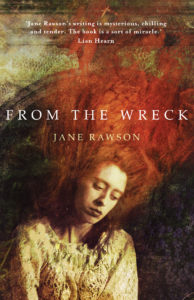A Lovely Way to Burn – Louise Welsh
From the Wreck – Jane Rawson
‘A Lovely Way to Burn’ is a hybrid novel – part dystopian thriller, part crime novel. Ex-journalist Stevie is working as a presenter on a TV shopping channel in London when an epidemic of illness strikes, peo ple call it ‘the sweats’. Like a flu outbreak, no one thinks much of it until people start dying, quickly. Stevie is initially oblivious and waits in a bar for her new boyfriend to turn up, when he doesn’t she goes to his flat and finds him dead. Maybe its natural causes but she succumbs herself to the sweats before she think much about it. When she recovers (one of the few, it transpires, who do) she finds a letter to her from her boyfriend, a successful paediatrician, asking her to deliver a laptop to another doctor at the hospital where he worked, and to trust no one. As she tries to carry out this request, she has to navigate a London slowly shutting down as more and more people die. To make matters worse, it looks like someone is prepared to bash her, or worse, to get their hands on the laptop.
ple call it ‘the sweats’. Like a flu outbreak, no one thinks much of it until people start dying, quickly. Stevie is initially oblivious and waits in a bar for her new boyfriend to turn up, when he doesn’t she goes to his flat and finds him dead. Maybe its natural causes but she succumbs herself to the sweats before she think much about it. When she recovers (one of the few, it transpires, who do) she finds a letter to her from her boyfriend, a successful paediatrician, asking her to deliver a laptop to another doctor at the hospital where he worked, and to trust no one. As she tries to carry out this request, she has to navigate a London slowly shutting down as more and more people die. To make matters worse, it looks like someone is prepared to bash her, or worse, to get their hands on the laptop.
Stevie does all the normal things a crime character has to, interview people, follow up leads, outwit the masked man following her, piece together the puzzle that goes deep into clinical trials and corporate greed, amid a populous getting more and more desperate. I liked the way that the pandemic starts slowly and societal structures work for a while, and some people (including Stevie) try to carry on as normal for as long as possible. The detail is all there: choked hospitals, eerily quiet roads as people are instructed to stay home, outbreaks of vigilantism and random violence. Stevie is tough but aware of her own vulnerabilities, and the brief relationship she has with a computer hacker who helps her is a welcome respite against the horrors all around.
The hybrid nature of ‘A Lovely Way to Burn’ reminded me of another novel I’ve read recently: Jane Rawson’s ‘From the Wreck’. This is an amalgam of Australia historical fiction (it is set in SA in the 1860s) and science fiction. You might think ‘steampunk’ but the novel is a far cry from that. It is really a thoughtful exploration of loneliness and being ‘other’. The novel centres around George, a steward on a ship that is wrecked off the coast of South Australia. While the survivors are slowly dying of starvation, a strange woman appears among them – she may or may not be Bridget Ledwith, one of the passengers. George and this woman are the only survivors but the woman disappears soon after they are rescued.
survivors are slowly dying of starvation, a strange woman appears among them – she may or may not be Bridget Ledwith, one of the passengers. George and this woman are the only survivors but the woman disappears soon after they are rescued.
George is forever after affected by the strange things that happened to him on the wreck. Meanwhile a sea-dwelling being from another world has seized upon him as their first contact with a human. The creature is desperately alone: ‘They are gone home and I am here and I am a million years too late’. To stay near George, the being fuses with George’s son Henry who develops a precocious interest in arcane (mostly natural history) knowledge. Another character Beatrice Gallwey, hard-drinking and tough, moves next door and we think she may be worthy foil for our extra-terrestrial. The interaction, and self-interest, of these four characters plays out to an ending that was, for me, unresolved. Rawson set herself a massive task to get these strands to work together; I enjoyed the parts: the other-worldliness of the creature, Rawson’s depiction of the rambunctious George who is alternately self-assured and terrified, her lovely portrait of young Henry who is at once enhanced and used by the creature, and the self-contained and cold Bea who pleases herself (below the radar) in a conventional society. Mixing these strands together didn’t quite work for me but it was interesting to go along with the ride wondering where this strange story was heading to next.

